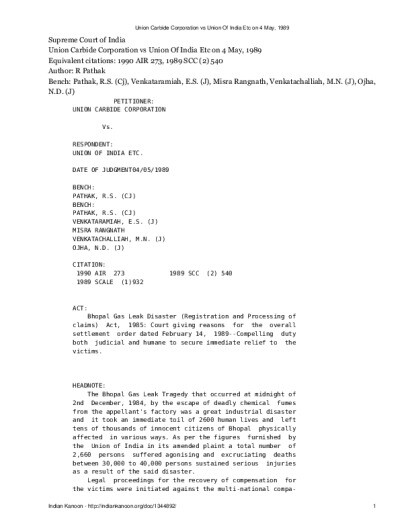
Date
Geographical Area
South Asia
Countries
India
Case Name
Union Carbide Corporation v. Union of India (UOI) & Ors
Case Reference
1990 AIR 273
Name of Court
Supreme Court of India
Key Facts
The company UCIL was formed by Union Carbide Corporation (51%) and the Union of India (49%). The company opened a plant in Bhopal in 1969 to produce the pesticide Sevin. On the night of 3-4 December 1984, Methyl-Isocyanate (MIC) was emitted from the plant, causing the deaths of approximately 2,600 people, in addition to between 30,000 and 40,000 sustaining serious injuries. In 1985, the Indian Government passed the Bhopal Gas Leak Act establishing the government as the sole legal representative for victims of the disaster.
Initially, legal proceedings against Union Carbide were taken in the US court system. After the case was held to be outside of US jurisdiction, claims were taken to Bhopal District Court. This judgment was appealed to Madhya Pradesh High Court, which granted interim compensation of INR₹2.5 billion. On 14 February 1989, the Supreme Court of India directed a final settlement of US$470 million. Due to the need to provide immediate relief to victims of the disaster, the rationale for this settlement was set out on a later date of 4 May 1989.
Initially, legal proceedings against Union Carbide were taken in the US court system. After the case was held to be outside of US jurisdiction, claims were taken to Bhopal District Court. This judgment was appealed to Madhya Pradesh High Court, which granted interim compensation of INR₹2.5 billion. On 14 February 1989, the Supreme Court of India directed a final settlement of US$470 million. Due to the need to provide immediate relief to victims of the disaster, the rationale for this settlement was set out on a later date of 4 May 1989.
Decision and Reasoning
One of the main factors for granting the order on 14 February was the compelling need to provide immediate relief. After considering the scale of the disaster, the complexities of the legal question involved and the delays inherent in the judicial process in India, the court decided that a quick settlement would be of greater benefit to the victims. In determining whether the amount of the settlement was reasonable, the court considered how to avoid delays, uncertainties and assure immediate payment. Counter offers between the parties, ranging from US$426 to 500 million were taken into account. The court also noted the official death count and the number of people treated in hospital as indicators. The Supreme Court upheld the High Court’s decision to discard the ordinary tort standards of compensation and instead adopt a higher standard given the serious nature of the incident.
Outcome
Union Carbide Corporation was ordered to pay US$470 million to the Union of India in full settlement of all claims, rights and liabilities related to and arising out of the Bhopal Gas Disaster on or before 31 March 1989. All civil proceedings related to the disaster were concluded and all criminal proceedings quashed. This order was made on the premise that the Government of India had the exclusive statutory authority to represent and act on behalf of the victims of the disaster, that the Bhopal Gas Leak Disaster Act 1985 was valid law.
Disclaimer
This case law summary was developed as part of the Disaster Law Database (DISLAW) project, and is not an official record of the case
Document
Document